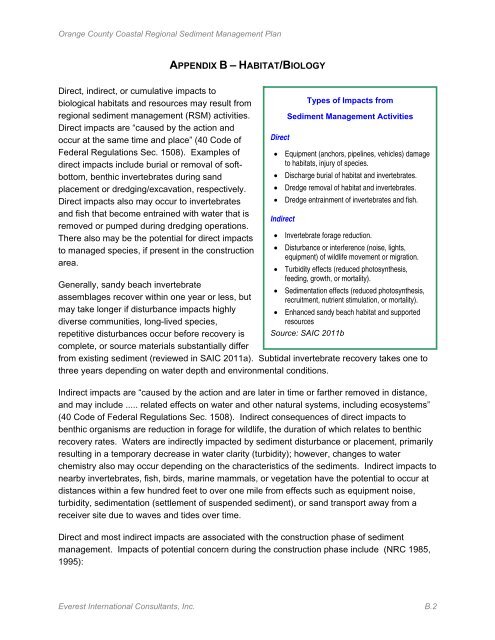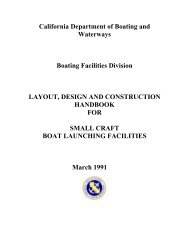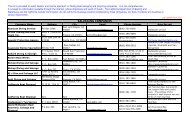EVEREST June, 2013 - California Department of Boating and ...
EVEREST June, 2013 - California Department of Boating and ...
EVEREST June, 2013 - California Department of Boating and ...
Create successful ePaper yourself
Turn your PDF publications into a flip-book with our unique Google optimized e-Paper software.
Orange County Coastal Regional Sediment Management Plan<br />
APPENDIX B – HABITAT/BIOLOGY<br />
Direct, indirect, or cumulative impacts to<br />
biological habitats <strong>and</strong> resources may result from<br />
regional sediment management (RSM) activities.<br />
Direct impacts are “caused by the action <strong>and</strong><br />
occur at the same time <strong>and</strong> place” (40 Code <strong>of</strong><br />
Federal Regulations Sec. 1508). Examples <strong>of</strong><br />
direct impacts include burial or removal <strong>of</strong> s<strong>of</strong>tbottom,<br />
benthic invertebrates during s<strong>and</strong><br />
placement or dredging/excavation, respectively.<br />
Direct impacts also may occur to invertebrates<br />
<strong>and</strong> fish that become entrained with water that is<br />
removed or pumped during dredging operations.<br />
There also may be the potential for direct impacts<br />
to managed species, if present in the construction<br />
area.<br />
Generally, s<strong>and</strong>y beach invertebrate<br />
assemblages recover within one year or less, but<br />
may take longer if disturbance impacts highly<br />
diverse communities, long-lived species,<br />
repetitive disturbances occur before recovery is<br />
complete, or source materials substantially differ<br />
Direct<br />
Types <strong>of</strong> Impacts from<br />
Sediment Management Activities<br />
• Equipment (anchors, pipelines, vehicles) damage<br />
to habitats, injury <strong>of</strong> species.<br />
• Discharge burial <strong>of</strong> habitat <strong>and</strong> invertebrates.<br />
• Dredge removal <strong>of</strong> habitat <strong>and</strong> invertebrates.<br />
• Dredge entrainment <strong>of</strong> invertebrates <strong>and</strong> fish.<br />
Indirect<br />
• Invertebrate forage reduction.<br />
• Disturbance or interference (noise, lights,<br />
equipment) <strong>of</strong> wildlife movement or migration.<br />
• Turbidity effects (reduced photosynthesis,<br />
feeding, growth, or mortality).<br />
• Sedimentation effects (reduced photosynthesis,<br />
recruitment, nutrient stimulation, or mortality).<br />
• Enhanced s<strong>and</strong>y beach habitat <strong>and</strong> supported<br />
resources<br />
Source: SAIC 2011b<br />
from existing sediment (reviewed in SAIC 2011a). Subtidal invertebrate recovery takes one to<br />
three years depending on water depth <strong>and</strong> environmental conditions.<br />
Indirect impacts are “caused by the action <strong>and</strong> are later in time or farther removed in distance,<br />
<strong>and</strong> may include ..... related effects on water <strong>and</strong> other natural systems, including ecosystems”<br />
(40 Code <strong>of</strong> Federal Regulations Sec. 1508). Indirect consequences <strong>of</strong> direct impacts to<br />
benthic organisms are reduction in forage for wildlife, the duration <strong>of</strong> which relates to benthic<br />
recovery rates. Waters are indirectly impacted by sediment disturbance or placement, primarily<br />
resulting in a temporary decrease in water clarity (turbidity); however, changes to water<br />
chemistry also may occur depending on the characteristics <strong>of</strong> the sediments. Indirect impacts to<br />
nearby invertebrates, fish, birds, marine mammals, or vegetation have the potential to occur at<br />
distances within a few hundred feet to over one mile from effects such as equipment noise,<br />
turbidity, sedimentation (settlement <strong>of</strong> suspended sediment), or s<strong>and</strong> transport away from a<br />
receiver site due to waves <strong>and</strong> tides over time.<br />
Direct <strong>and</strong> most indirect impacts are associated with the construction phase <strong>of</strong> sediment<br />
management. Impacts <strong>of</strong> potential concern during the construction phase include (NRC 1985,<br />
1995):<br />
Everest International Consultants, Inc. B.2




